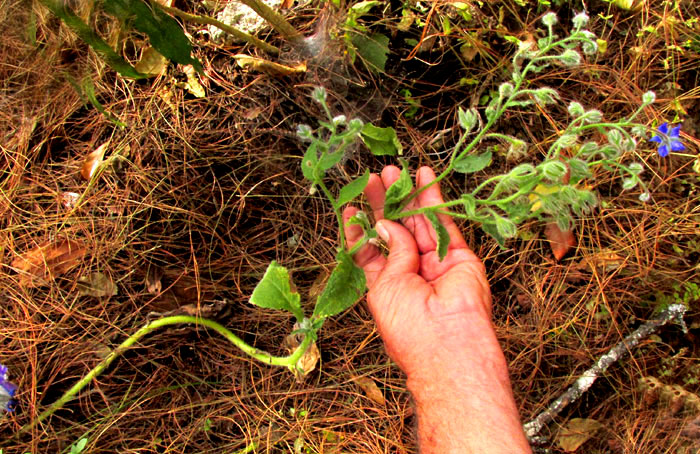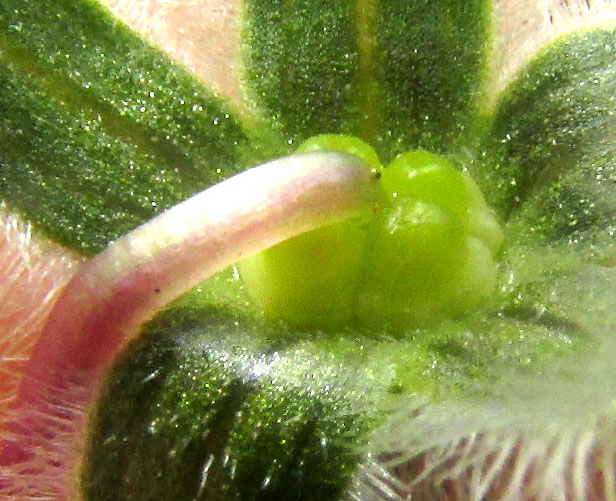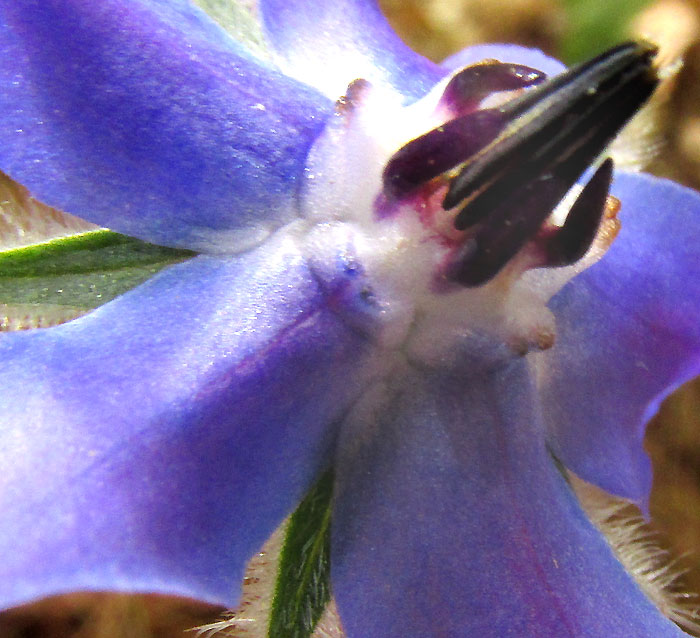Excerpts from Jim Conrad's
Naturalist Newsletter
entry from field notes dated January 19, 2023, taken along steep, one-lane gravel road ascending forested, northeast-facing mountain slope, elevation ±2,380m (7600 ft); bedrock of Cretaceous limestone; on the south side of Pinal de Amoles, Querétaro state, MÉXICO, (N21.134°, W99.629°)
BORAGE

The above lanky, drought-suffering herb occupied a pine-straw covered roadcut beside the narrow, rocky road up the mountain. Despite its lower leaves drying up and dying, it had produced numerous flowers, and still was producing some very attractive ones:

The plant's long, stiff, white hairs not only dissuaded creatures such as caterpillars from feeding on the plant, but also added to its attractiveness. The inflorescence itself was curious because at first it looked like a typical raceme -- stalked flowers arising from a central stem, or rachis -- but along the rachis inside the inflorescence leafy bracts arose at odd places, and the lower bracts were large and leaf-like. Normally such large bracts don't appear inside a raceme, and if bracts do grow there, flowers arise where the bracts attach to the rachis, not between the bracts.

Above it's seen that each flower stalk, or pedicel, curved, causing the flowers to droop and face downward.

Beneath the calyx, where it attaches to the flower's pedicel, there were the four bulges shown above.

However, nothing was as interesting, and confusing, as the flower structure itself. The 5-petaled corolla with widely spreading lobes, and the exceptionally large stamens gradually becoming narrower at the top was very similar to what's seen in the big genus Solanum, the nightshade/tomato genus. But Solanum flowers have 5 stamens, while the blossom above appears to bear 4 especially tall stamens, plus 5 shorter, horn-like items surrounding the stamens. Solanum can't do all that, and I didn't know of any plant family that could.
I interpreted the five, horn-like items as aborted stamens known as staminodes, but later I'd learn that technically they're "filament appendages," not staminodes. Also, the stamens with their filament appendages arise from a white disc, which I interpreted as a "nectiferous disc" with little bumps along the disc's margin producing nectar. But the experts consider the white part a corona with scales. My misinterpretations resulted in much time spent trying to figure out what this was.
The wide, soft, hairy leaves and drooping blue flowers were suggestive of the garden favorite called Comfrey, a member of the Borage Family, the Boraginaceae. However flowers in that family bear 5 stamens, not four like our flower. That detail was misleading because in the end our plant revealed itself as a member of the Borage Family, and our flower was just an oddity.
In fact, our plant is Borage itself, BORAGO OFFICINALIS, a native of the eastern Mediterranean region, but very much planted in gardens worldwide, where it often escapes into the wild to become established as a free-living weed. Just a stone's throw upslope from our plant there was a rustic homestead with various ornamental and medicinal plants growing around it, so maybe our plant developed from seeds from there. In gardens, Borage plants develop into handsome, erect but spreading groupings like Comfrey, up to 1m tall (4ft), so our roadcut plant was on its steep, dry slope was definitely stunted, and that may be behind our blossom producing only four stamens instead of five.
Having the plant's name, the value of those four strange bumps at the calyx's base could be sought. Ernest Stawiarz and others in their 2020 publication "Flowering, Forage Value, and Insect Pollination in Borage (Borago Officinalis L.) Cultivated in Se Poland" describes the four bulges as constituting a "nectary ring," each bump corresponding to one of the four separate divisions of the 4-parted ovary above them. Each projection bears a "nectary epidermis with a nectarostoma," nectarostomas being holes in the epidermis through which nectar is exuded. It appears that in Borage pollinators are encouraged to seek nectar beneath the base of the downward nodding flowers -- so the flowers' bases would face upwards -- not inside the flowers themselves.
In Europe, Borage often is grown as an edible vegetable, in Germany its leaves added to soups, also made made into a green sauce called grüne Soße. In Italy it's used as a filling in traditional pasta, and in Poland and Russia it flavors pickled gherkins. In Iran they make Borage tea. Sometimes gardeners like to grow it as a companion plant in their garden, thinking it might be helping their other plants. However, the largest Borage plantings are commercial ones, for the production of Borage seed oil, use as a nutritional supplement rich in essential fatty acids, which can regulate the body's immune system and fight joint inflammation.
In Mexico there's a long history of Borage's use in traditional medicine. The Atlas de las Plantas de la Medicina Tradicional Mexicana tells us that Gregorio López, born in Spain but coming to Mexico as a young man, often living with indigenous people (living from 1542 to 1596), wrote what in English translates to this: "It purges melancholy, strengthens the vital virtue and brightens the spirit, removes tertians and quartans (illness reappearing every three or four days). It eats superfluous meat from sores, clears the blood, comforts the vital members, lengthens slack (?), removes jaundice and benefits the liver." The Atlas goes on to say that nowadays Borage is mainly used against the cough and bronchitis. In other places it has many other uses. Borage must have been one of the very first Old World plants brought to Mexico, for the first European didn't arrive here until 1511.
According to the WebMD.COM website, there's research suggesting that certain of the above cures may be supported by scientific studies. For instance, "There is some evidence that borage seed oil, when taken by mouth in combination with eicosapentaenoic acid (EPA), might reduce the number of days spent in the intensive care unit (ICU) and the length of time a breathing machine is needed by patients with acute respiratory distress syndrome (ARDS)."
On the other hand, it's noted that using Borage oil may be unsafe when used with certain other medications. The oil might prolong a wound's bleeding time, and could make liver disease worse. During pregnancy and breast-feeding it may be advisable to avoid using Borage.